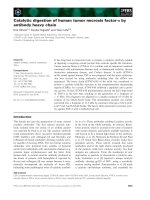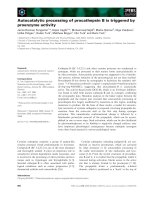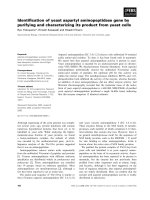Báo cáo khoa học: Catalytic transformations of supercoiled DNA as studied by flow linear dichroism technique doc
Bạn đang xem bản rút gọn của tài liệu. Xem và tải ngay bản đầy đủ của tài liệu tại đây (312.97 KB, 8 trang )
Catalytic transformations of supercoiled DNA as studied
by flow linear dichroism technique
Alexander Gabibov
1,2,3,
*, Elena Yakubovskaya
1
, Mark Lukin
4
, Peter Favorov
3
, Andrey Reshetnyak
5
and Michael Monastyrsky
2,6,
*
1 Shemyakin and Ovchinnikov Institute of Bioorganic Chemistry, Russian Academy of Sciences, Moscow, Russia
2 Max-Plank-Institute for Physics of Complex Systems, Dresden, Germany
3 Engelhardt Institute of Molecular Biology, Russian Academy of Sciences, Moscow, Russia
4 Institute of Experimental Cardiology, Cardiology Research Center, Moscow, Russia
5 Moscow State University, Chemical Department, Vorobjovy Gory, Moscow, Russia
6 Institute of Theoretical and Experimental Physics, Russian Academy of Sciences, Moscow, Russia
The dynamic of supercoiled DNA (scDNA) transfor-
mations is the key point for understanding the numer-
ous processes taking place in the living cell [1]. DNA
topology changes are vital in replication, transcription,
recombination, chromosome condensation, and segre-
gation. From the topological point of view DNA can
be represented as a closed ribbon [2–4]. A study of the
dynamic aspects of the DNA topology is closely associ-
ated with a design of an adequate mathematical des-
cription of the DNA polymeric molecule and methods
for monitoring its properties [5–8]. The main topologi-
cal changes of scDNA are catalyzed by DNA-topo-
isomerases I and II, which induce single and double
nicks in DNA strains, respectively. These correspond to
changes in the linking number (Lk) of the polymer sub-
strate by 1 or 2. From the chemical point of view, the
substrates and products of DNA topoisomerization are
identical and catalytic events result in only slight topo-
logical changes. The product of the previous turnover
acts as a substrate at the next stage, so an ensemble of
topoisomers exists at each step of the reaction. This
fact stipulates a description of scDNA biocatalytic
Keywords
anticancer drugs; flow linear dichroism;
supercoiled DNA transformations;
topoisomerases
Correspondence
A. Gabibov, Shemyakin and Ovchinnikov
Institute of Bioorganic Chemistry, Russian
Academy of Sciences, 16 ⁄ 10 Mikluho-
Maklaya str., 117871, Moscow, Russia
Fax: +7095 3107007
Tel: +7095 4298269
E-mail:
*Note
A. G. and M. M. were visiting scientists.
(Received 28 February 2005, revised 13
September 2005, accepted 19 October
2005)
doi:10.1111/j.1742-4658.2005.05027.x
A catalytic turnover of supercoiled DNA (scDNA) transformation medi-
ated by topoisomerases leads to changes in the linking number (Lk) of the
polymeric substrate by 1 or 2 per cycle. As a substrate of the topoisomeri-
zation reaction it is chemically identical to its product; even a single
catalytic event results in the quantum leap in the scDNA topology.
Non-intrusive continuous assay to measure the kinetics of the scDNA
topoisomerization was performed. The development of such a technique
was hindered because of multiple DNA species of intermediate topology
present in the reaction mixture. The interrelation of DNA topology, its
hydrodynamics, and optical anisotropy enable us to use the flow linear
dichroism technique (FLD) for continuous monitoring of the scDNA topo-
isomerization reaction. This approach permits us to study the kinetics of
DNA transformation catalyzed by eukaryotic topoisomerases I and II, as
well as mechanistic characteristics of these enzymes and their interactions
with anticancer drugs. Moreover, FLD assay can be applied to any enzy-
matic reaction that involves scDNA as a substrate. It also provides a new
way of screening drugs dynamically and is likely to be potent in various
biomedical applications.
Abbreviations
AMPPNP, adenosine-5¢-phosphate-b,c-iminodiphosphate; FLD, flow linear dichroism; Lk, linking number; scDNA, supercoiled DNA;
Tw, twist; Wr, writhing; q, linear dichroism value; r, supercoiling density.
6336 FEBS Journal 272 (2005) 6336–6343 ª 2005 The Authors Journal compilation ª 2005 FEBS
transformations within the DNA topology, as well as
hydrodynamics and statistics of biopolymers. How-
ever, lack of an adequate nonintrusive technique for
quantitative estimation of enzyme-mediated scDNA
transformations makes the above-mentioned considera-
tion inapplicable. Time-dependent topological trans-
formations of the scDNA can be experimentally
investigated by electrophoretic separation of DNA
in the reaction mixture probes at different stages.
However, this technique cannot provide instant and
nondisturbing quantitative kinetic analysis, especially
in the case of tiny inhibitory effects. A recently pub-
lished precise approach based on immobilization of a
single DNA molecule demands a state-of-the-art tech-
nique and cannot be utilized in routine quantitative
monitoring [9].
We proposed to use flow linear dichroism (FLD) to
monitor different nuclease reactions. This allowed us
to estimate kinetic parameters of enzymes and abzymes
using the flow-oriented scDNA molecule as a substrate
[10–14]. The application of FLD to study nucleic acids
has been extensively reviewed in [15]. This method is
based on the fact that oriented DNA possesses the
property of optical anisotropy. The polymer molecule
changes its topology, by low-molecular weight effectors
(such as benzpyrene) [16,17], influencing its hydrody-
namics, which affects orientation and optical factors.
Thus, FLD allowed characterization of the interaction
of the DNA molecule with intercalators and drugs,
and to estimate the interaction geometry [18,19]. This
technique turned out to be adequate to discriminate
intercalators by the mode of their interaction with
DNA. A number of DNA–protein complexes, inclu-
ding specific receptors, were studied by the FLD
method [20,21]. These data initiated us to apply FLD
in biocatalytic studies.
In this paper, we attempt to substantiate the applica-
bility of the FLD technique for an adequate monitor-
ing of enzyme-induced changes in highly supercoiled
DNA topology. We use this method for mechanistic
studies of DNA topoisomerases and the mechanisms
of drug targeting.
Results and discussion
Flow linear dichroism and dynamics of DNA
supercoiling
DNA topisomerases are considerably smaller than
their natural substrates, large scDNAs. Consequently,
the enzymes cannot recognize the global shape param-
eters of DNA, i.e. their writhe or twist. The use of a
length-independent parameter, the parameter reflecting
a local alteration of DNA geometry, seems reasonable
for the description of the substrate properties of
scDNA caused by supercoiling which might be recog-
nized by topoisomerases. A well-known parameter,
superhelix density r, could be applied for this purpose.
Thus, superhelix density may be represented as:
r ¼ DLk=Lk
0
¼ cDLk=N ð1Þ
where N is the number of base pairs in the DNA mole-
cule and c is the mean number of base pairs per turn
of the double helix under the given conditions [8].
It is known [8] that the only energy source determin-
ing both the rate and direction of the topoisomeriza-
tion process catalyzed by topoisomerase types I and II
is a steric strain in the scDNA. Thus the equation
combining the free energy of DNA supercoiling, the
DNA length and the superhelix density can be derived
[22]. It is proportional to square r
2
:
DG
r
=N ¼ 10RTr
2
ð2Þ
As mentioned above, r, a single parameter independ-
ent of DNA length, describes both normalized confor-
mation properties of DNA (most probably, affecting
enzyme binding) and normalized energy (driving topo-
isomerization). Consequently, r can be regarded as a
universal parameter reflecting the substrate properties
of scDNA.
The value of reduced linear dichroism, q, is defined
as a ratio between DA, the difference in light absorp-
tion, polarized parallel and perpendicular to the DNA
orientation axis, and A, the optical density of a sample
in nonpolarized light [23]. It depends on the optical
anisotropy of an individual molecule and on the aver-
age orientation of these molecules in the sample relat-
ive to the laboratory axis.
The q(r) function was used for monitoring topo-
isomerase-induced transition in DNA molecules.
Strong dependence of reduced FLD (q) on its superhe-
lix density (r) was first observed for circular DNA.
Titration of the sc DNA pIBI30 [24] or /X174 phage
[16,17] with intercalating dyes, which unwind DNA
and change its topological state, revealed the bell-
shaped dependence of q on r, with the maximum
value of q corresponding to the nonsupercoiled
(relaxed) DNA. Our measurements demonstrated close
dependence; however these differed from data pub-
lished in [12,25]. The ethidium bromide titration curve
of pUC19 plasmid according to those data had the
maximum, corresponding to completely unwound
DNA. However, at r ¼ )0.04, an FLD signal reached
its minimum value, increasing thereafter (Fig. 1). Qual-
itatively similar behavior was also demonstrated
by other plasmids under study, including pTM and
A. Gabibov et al. DNA topoisomerization studied by FLD
FEBS Journal 272 (2005) 6336–6343 ª 2005 The Authors Journal compilation ª 2005 FEBS 6337
BlueScript (data not shown). To the best of our know-
ledge, an increase in the FLD signal for highly negat-
ive supercoiled circular DNA has not been previously
reported.
According to [15], the tertiary structure of DNA is
represented as a superhelix with radius R and pitch P.
For such an oriented DNA, linear dichroism value can
be represented as product of orientation factor S and
optical factor O
q ¼ SO ¼ 1=2ð3 <Cos
2
H> À 1Þ1=2ð3 <Cos
2
b> À 1Þ
ð3Þ
where Q is an angle between the DNA axis and the
unique laboratory axis, and b a pitch angle of the
superhelix, b ¼ tan
)1
(2pR ⁄ P) [15]. Reduction of |q|
upon increase of |r| was primarily associated with a
decrease of the optical factor, which for the pitch
angle 50° was as low as 0.12. However, electron
microscopy data established that if the superhelix
density r of circular DNA molecules ranged from
)0.019 to )0.12, then R and P decreased proportion-
ally [26] As a result, the pitch angle b appeared to
be almost constant ($56°) for all topological states
studied. On the other hand, the FLD value and sedi-
mentation coefficients for circular DNA in a wide
range of topological states were in perfect accord-
ance [27]. This correlation demonstrates that hydro-
dynamics of circular DNA can explain a change in
the FLD value upon increase of |r|. In contrast to
the relaxed DNA, which represents a loose loop,
well-aligned along a sheared flow, scDNA behaves as
a dense, shortened and rigid rod with impaired ori-
entation ability. In the case of highly supercoiled
long DNA the orientation could be better than that
for its relaxed form [28]. Experimental measurements
of sedimentation coefficients of PM2 [29], and SV40
[30] DNA demonstrated that the latter appeared to
be a minimum for the relaxed DNA, and reached its
maximum at r ¼ )0.04, then dropped again at more
negative r values. Monte-Carlo simulation for PM2
[8] reproduced experimental data and demonstrated
that at r < )0.05 DNA had a less branched and
more extended conformation. As this conformation
facilitates DNA orientation in the shear flow, our
observation agrees well with the above data.
Interaction of scDNA with eukaryotic
DNA-topoisomerases
Let us consider a sample of the flow-oriented circular
plasmid DNA undergoing enzyme-induced topoisome-
rization. At time point ‘t’, the state of the reaction
mixture could be described using the function S(s,t),
which determines the total length of DNA segments
(i.e. a fraction of circular DNA) with the given super-
helix density s. At any time point ‘t’, this function pos-
sesses a property:
Z
Sðr; tÞdr ¼ DNA½ ð4Þ
An instant value of the reduced FLD at time t could
be represented as:
qðtÞ¼
Z
Sðr; tÞqðrÞdr ð5Þ
Thorough analysis of the function S(s,t) using the
FLD time dependence is not a straightforward task.
However, data analysis could be easily performed for
at least two types of reaction conditions:
(1) After binding the enzyme to the supercoiled
DNA, fast and virtually complete relaxation of DNA
has taken place, followed by dissociation of the result-
ing enzyme–relaxed DNA complex (processive mech-
anism). This process presumably occurs in eukaryotic
topoisomerase I [31,32], and in topoisomerase II under
optimum conditions. As a result, a bimodal distribu-
tion of topoisomers is observed [S(s,t) has two max-
ima]. The first maximum corresponds to an initial
topological state of DNA and the second represents a
fully relaxed form, so Eqn (5) can be rearranged to
Eqn (6):
Fig. 1. Correlation between supercoiling density of plasmid DNA
and linear dichroism value. Here linear dichroism of the sample is
presented as relative value q, which is zero for the reaction buffer
and 1 for the original plasmid sample. Supercoiling density is
altered by titration with ethidium bromide.
DNA topoisomerization studied by FLD A. Gabibov et al.
6338 FEBS Journal 272 (2005) 6336–6343 ª 2005 The Authors Journal compilation ª 2005 FEBS
qðtÞ¼ DNA½ f½ð1 À kðtÞqðs
init
ÞþkðtÞqðr
fin
Þg; ð6Þ
where k(t) is a degree of DNA conversion.
(2) When the enzyme changes the DLk of DNA
strictly by l (for prokaryotic topoisomerase I) or by 2
(for eukaryotic topoisomerase II) with the following
ligation of the gap formed, and dissociation from
DNA, a distributive mechanism occurs. In this case,
S(s,t) may have only one maximum at any time point,
this maximum is drifting toward a state with s ¼ 0. If
dispersion is low enough, S(s,t) could be approximated
as a product: [DNA] <s(t)>, so the observed FLD sig-
nal is expressed as:
qðtÞ¼ DNA½q½<rðtÞ>ð7Þ
In other words, the q(t) function will be close
to the intercalating agent titration curve (Figs 1
and 2).
Figure 3 displays kinetic curves q(t) for human
topoisomerases I and II, obtained by monitoring of
the FLD signal during the incubation of enzymes with
pUC19. These enzymes display dramatically different
kinetic curves. The pseudo-first order kinetics is
observed for topoisomerase I. Similar observation was
made by Pulleyblank and Ellison [33] in the experi-
ment based on registration of the intercalating agent
fluorescence during the DNA topoisomerization. For
topoisomerase II the kinetic curve agrees well with the
DNA titration curve by ethidium bromide (Fig. 1).
The differences can be explained by a different
enzyme mechanism of action. As in case of topoisom-
erase I we observed only initial and final DNA forms
present in the reaction mixture. On the other hand,
for topoisomerase II under experimental conditions
(rather a high enzyme ⁄ DNA ratio) the concentration
of intermediate topoisomers is significant. When the
enzyme ⁄ DNA ratio decreases, the local minimum of
AB
Fig. 2. Mechanisms of action of enzymes of DNA topoisomerization. (A) Topoisomerase I-3¢. (B) Topoisomerase II. Two possible ways of
action of topoisomerase I are shown, see text, as well as distributive and processive characters of catalysis by topoisomerase II.
Fig. 3. FLD monitoring of kinetics of topoizomerization pUC19 plas-
mid DNA (8 lg) catalyzed by human topoisomerase I-3¢ (0.45 l g)
and topoisomerase II (4 lg) in reaction buffer.
A. Gabibov et al. DNA topoisomerization studied by FLD
FEBS Journal 272 (2005) 6336–6343 ª 2005 The Authors Journal compilation ª 2005 FEBS 6339
q(t) is expressed less; at high excess of the substrate
it never reaches the minimum value q
min
(data not
shown).
Dynamics of drug targeting
The FLD technique proves very useful for studying
the topoisomerases interactions with various inhibitors
and poisons [34,35]. These effectors are of interest
because of their high antitumor activity [36]. As an
example, we used a number of relatively well-studied
compounds, some of them applied earlier as anticancer
drugs. For topoisomerase I, camptothecin (CPT) and
its two analogues, 10,11-ethylenedioxycamptothecin
(MCPT-10,11) and 7-ethyl-10-hydroxycamptothecin
(SN-38) (see Fig. 4) were taken. These drugs are
known to inhibit the process at the religation stage of
the nicked DNA chain (see Fig. 2A) [37,38]. As shown
in Fig. 4, kinetic curves retain their exponential
character at increasing concentrations of CPT and
MCPT-10,11. For these compounds I
50
can be estima-
ted as 1 and 0.1 lm, respectively. On the contrary,
SN-38 (Fig. 4) does not affect the reaction rate at the
initial stage, but effectively inhibits it afterwards (I
50
for the second portion is 0.2 lm). We propose that the
FLD technique here promotes to distinguish between
the mechanisms of action of these closely related com-
pounds. The three inhibitors, as previously reported,
hinder the DNA religation; CPT and MCPT-10,11 also
impede the initial enzyme–DNA interactions, while
SN-38 lacks this additional activity (see Fig. 2A).
For topoisomerase II, we chose two compounds
with totally different modes of action: etoposide
[39] and adenosine-5¢-phosphate- b,c-iminodiphosphate
(AMPPNP) [40]. The first one-etoposide, now a wide-
spread chemotherapeutic drug, is a classic topoiso-
merase II poison, acting by binding to single-stranded
DNA ends and inhibiting the religation of the hydro-
lyzed DNA segment (see Fig.2B) [41]. This inhibitor
does not dramatically change the kinetic curve; etopo-
side makes the whole process slower. The local mini-
mum of q(t) in this case is less expressed (Fig. 5A).
Using the initial rates, we found the I
50
value for this
compound to be equal to 10 lm.
Other topoisomerase II effectors, such as AMPPNP,
are non hydrolysable analogues of ATP [42,43]. AMP-
PNP blocks the ATP-dependent turnover of the type
II enzyme. If the AMPPNP molecule binds to one or
both topoisomerase II subunits, the enzyme remains in
the ‘closed clamp’ conformation, topologically bound
to the closed DNA molecule, which is kinetically and
irreversibly inactivated (Fig. 2B). If ATP and AMP-
PNP are present in the reaction mixture, only a certain
portion of enzyme molecules is inactivated at each
catalytic step. As shown in Fig. 5B, the reaction under
these conditions does not reach an equilibrium state,
but kinetic curves achieve the plateau at the values of
the FLD signal corresponding to r <0.
Conclusion
The intrinsic connection between DNA topology,
and the hydrodynamic and optical properties dis-
cussed in this paper enables us to study experiment-
Fig. 4. The effect of increasing concentrations of several campothe-
cine analogues on the kinetics of topoisomerization of pUC19 DNA
(8 lg) by topoisomerase I (0.45 lg): (A) 0 (curve 1), 0.25 (2), 0.5
(3), 0.75 (4), 1.25 (5), and 12.5 (6) l
M CPT; (B) 0 (curve 1), 0.05 (2),
0.075 (3), 0.125 (4), and 0.25 (5) l
M MCPT-10,11; (C) 0 (curve 1),
0.075 (2), 0.15 (3), 0.2 (4), and 0.25 (5) l
M SN-38. Inserts: enlarged
initial portions of graphs and chemical formulas of each inhibitor.
DNA topoisomerization studied by FLD A. Gabibov et al.
6340 FEBS Journal 272 (2005) 6336–6343 ª 2005 The Authors Journal compilation ª 2005 FEBS
ally the dynamics of DNA relaxation. The major
functional dependence of the FLD signal on the
DNA topology makes possible continuous analysis
of DNA topoisomerization. The proposed technique
is a unique nondisturbing procedure for estimating
kinetics in the enzyme-mediated changes of topologi-
cal parameters of the supercoiled plasmid DNA. It
allows display of the substrate properties directly
from the optic flow cell without additional proce-
dures with the sample, thus avoiding any other topo-
logical alterations not induced during the main
reaction.
This technique provided us with more data on the
topoisomerase I action. For the first time FLD
allowed the study of real-time kinetics of topoiso-
merase II. We believe the developed approach is
promising for analysis of the dynamics of drug target-
ing, which opens up various biomedical applications
including vast quantitative screening of antibacterial
and anticancer drugs.
Experimental procedures
Harvesting and purification of plasmid DNA
Ecolab DH5a strain was used for pUC19 amplification.
A standard method of lyses by alkali [44] was used for plas-
mid harvesting and purification. Phenol–chloroform extrac-
tion was used to separate plasmid DNA from protein
contamination. The separation of supercoiled and relaxed
form of pUC19 was performed by Cycle gradient
(1.55 gÆmol
)1
) ultracentrifugation.
Enzyme assay
TopoGEN Inc. topoisomerase I and II were used. The reac-
tion was carried out in the final volume of 220 lL. The
buffer for topoisomerase I was 0.02 m Tris pH 7.5, 0.1 m
NaCl, 0.5 mm EDTA and 75 lgÆml
)1
bovine serum albu-
min. Toboggan 1 · reaction buffer (0.05 m Tris pH 8.0,
120 mm KCL, 10 mm MgCl
2
, 0.5 mm ATP, and 0.5 mm
dithiothreitol, 30 lgÆmol
)1
bovine serum albumin) was used
in assay with topoisomerase II, 1 · reaction buffer was
obtained from 10 · stock solution. The reaction was ter-
minated with a 0.25 volume of the stop solution buffer (5%
sodium dodecyl sulfate, 0.0025% bromophenol blue, and
25% glycerol).
FLD technique
The signal of linear dichroism was measured on JASCO
J715 dichrograph equipped with achromatic quarterwave
prism (wavelength 260 nm). The gradient was formed in the
flow-through quartz cell (volume 200 lL) by reciprocating
pumping with frequency 100 min
)1
, using the same tech-
nique as described in [45]. After washing with Piranha solu-
tion the quartz details were rinsed with water, then treated
with 3-aminopropyltrietoxysilane (10% in ethanol, 10 min),
and a mixture of lutidine, acetyl anhydride, 4-dimethyl-
aminopyridine in tetrahydrofuran (5 : 5 : 1 : 50, 2 h), rinsed
with acetone, ethanol and water. Titration of 2–5 lgof
plasmid DNA by ethidium bromide was performed in
20 mm Tris ⁄ HCl (pH 7,5), with 100 mm NaCl and a 20 lm
solution of ethidium bromide. Supercoiling density was
calculated using standard unwinding value of ethidium
bromide of )26° per molecule. All new plasmid prepara-
tions were titrated with ethidium bromide before their use
in kinetic experiments.
The normalized FLD signal was used, where q of the reac-
tion buffer was taken as q ¼ 0 and the FLD signal of the ini-
tial supercoiled plasmid was taken as q ¼ 1. Experimentally
obtained kinetic curves (Figs 1 and 2 in supplementary
material section) were smoothed using Microsoft Excel.
Acknowledgements
We thank the late Professor Marat Karpeysky for
stimulating discussions and dedicate this paper to his
memory. We thank Mrs Tatyana Chernichko for
assistance in the paper preparation.
We thank the Russian Foundation for Fundamental
Investigations (00-04-48378, 99-01-00123) and the
Fig. 5. Inhibition of topoizomerase II activity measured by the FLD
technique. Comparison of the kinetics of inhibition of reaction of
8 lg of pUC19 DNA with 4 lg of topoisomerase II by etoposide
and AMPPNP. (A) 0 l
M (curve 1), 5 lM (2), 10 lM (3), 25 lM (4),
50 l
M (5) of etoposide; (B) ratio [AMPPNP] ⁄ ([ATP] + [AMPPNP]) ¼
0 (curve 1), 0.005 (2), 0.01 (3), 0.02 (4).
A. Gabibov et al. DNA topoisomerization studied by FLD
FEBS Journal 272 (2005) 6336–6343 ª 2005 The Authors Journal compilation ª 2005 FEBS 6341
Russian National Program of Support of Scientific
Schools (1800.22003.4).
References
1 Wang JC (1996) DNA topoisomerases. Annu Rev Bio-
chem 65, 635–692.
2 Crick FH (1976) Linking numbers and nucleosomes.
Proc Natl Acad Sci USA. 73, 2639–2643.
3 Fuller FB (1971) The writhing number of a space curve.
Proc Natl Acad Sci USA. 68, 815–819.
4 Fuller FB (1978) Decomposition of linking number of a
closed ribbon: a problem from molecular biology. Proc
Natl Acad Sci USA. 75, 3557–3561.
5 Cozzarelli N (1992) Evolution of DNA topology: impli-
cation for its biological roles. Proc Symp Appl Math 45,
1–17.
6 Frank-Kamenetskii MD (1993) Unraveling DNA. VCH
Publishers, New York.
7 Vologodskii AV, Anshelevich VV, Lukashin AV &
Frank-Kamenetskii MD (1979) Statistical mechanics of
supercoils and the torsional stiffness of the DNA double
helix. Nature 280, 294–298.
8 Vologodskii AV & Cozzarelli NR (1994) Conforma-
tional and thermodynamic properties of supercoiled
DNA. Annu Rev Biophys Biomol Struct 23, 609–643.
9 Strick TR, Croquette V & Bensimon D (2000) Single-
molecule analysis of DNA uncoiling by a type II topo-
isomerase. Nature 404, 901–904.
10 Favorov PV, Yakubovskaya EA, Reshetnyak AV &
Gabibov AG (2000) Kinetics of interactions between
DNA and topoisomerase II in the presence of physiolo-
gically active effectors. Dokl Biochem 370, 38–41.
11 Gabibov AG & Makarevitch O (1995) DNA hydrolysis
by antibodies. Methods Mol Biol 51, 223–235.
12 Gololobov GV, Chernova EA, Schourov DV, Smirnov
IV, Kudelina IA & Gabibov AG (1995) Cleavage of
supercoiled plasmid DNA by autoantibody Fab frag-
ment: application of the flow linear dichroism technique.
Proc Natl Acad Sci USA 92 , 254–257.
13 Iakubovskaia EA, Kudelina IA, Bronshtein IB & Gabi-
bov AG (1998) [A novel approach to the study of topo-
isomerase I kinetics], Dokl Akad Nauk. 361 , 837–838.
14 Shuster AM, Gololobov GV, Kvashuk OA, Bogomo-
lova AE, Smirnov IV & Gabibov AG (1992) DNA
hydrolyzing autoantibodies. Science 256, 665–667.
15 Norden B, Kubista M & Kurucsev T (1992) Linear
dichroism spectroscopy of nucleic acids. Q Rev Biophys
25, 51–170.
16 Swenberg CE, Carberry SE & Geacintov NE (1990)
Linear dichroism characteristics of ethidium- and profla-
vine-supercoiled DNA complexes. Biopolymers 29,
1735–1744.
17 Xu R, Birke S, Carberry SE, Geacintov NE, Swenberg
CE & Harvey RG (1992) Differences in unwinding of
supercoiled DNA induced by the two enantiomers of
anti-benzo[a]pyrene diol epoxide. Nucleic Acids Res 20,
6167–6176.
18 Lerman LS (1963) The structure of the DNA–acridine
complex. Proc Natl Acad Sci USA 49, 94–102.
19 Norden B & Tjerneld F (1976) High-sensitivity linear
dichroism as a tool for equilibrium analysis in biochem-
istry. Stability constant of DNA–ethidiumbromide com-
plex. Biophys Chem 4, 191–198.
20 Roca AI & Cox MM (1990) The RecA protein: struc-
ture and function. Crit Rev Biochem Mol Biol 25,
415–456.
21 Cox MM & Lehman IR (1987) Enzymes of general
recombination. Annu Rev Biochem 56, 229–262.
22 Vologodskii AV, Lukashin AV, Anshelevich VV &
Frank-Kamenetskii MD (1979) Fluctuations in super-
helical DNA. Nucleic Acids Res 6, 967–982.
23 Iakubovskaia EA & Gabibov AG (1999) [Topoiso-
merases. mechanisms of changing DNA topology], Mol
Biol (Mosk) 33, 368–384.
24 Balasta L, Xu R, Geacintov NE, Swenberg CE, Amin S
& Hecht SS (1993) Unwinding and hydrodynamic flow
linear dichroism characteristics of supercoiled DNA
covalently modified with two isomeric methylchrysene
diol epoxides of different biological activities. Chem Res
Toxicol 6, 616–624.
25 Iakubovskaia EA, Gololobov GV, Kudelina IA, Smir-
nov IV & Gabibov AG (1996) [A study of kinetics of
endonuclease reactions using flow linear dichroism tech-
nique]. Mol Biol (Mosk) 30, 1378–1384.
26 Boles TC, White JH & Cozzarelli NR (1990) Structure
of plectonemically supercoiled DNA. J Mol Biol 213,
931–951.
27 Yoshida H, Swenberg CE & Geacintov NE (1987)
Kinetic flow dichroism study of conformational changes
in supercoiled DNA induced by ethidium bromide and
noncovalent and covalent binding of benz[a]pyrene diol
epoxide. Biochemistry 26, 1351–1358.
28 Lee CS & Davidson N (1968) Flow dichroism of
deoxyribonucleic acid solutions. Biopolymers 6, 531–
550.
29 Wang JC (1974) Interactions between twisted DNAs
and enzymes: the effects of superhelical turns. J Mol
Biol 87, 797–816.
30 Upholt WB, Gray HB Jr & Vinograd J (1971) Sedimen-
tation velocity behavior of closed circular SV40 DNA
as a function of superhelix density, ionic strength, coun-
terion and temperature. J Mol Biol 62, 21–38.
31 Berger JM (1998) Type II DNA topoisomerases. Curr
Opin Struct Biol 8, 26–32.
32 Stewart L, Redinbo MR, Qiu X, Hol WG & Champoux
JJ (1998) A model for the mechanism of human topo-
isomerase I. Science 279, 1534–1541.
33 Pulleyblank DE & Ellison MJ (1982) Purification and
properties of type 1 topoisomerase from chicken
DNA topoisomerization studied by FLD A. Gabibov et al.
6342 FEBS Journal 272 (2005) 6336–6343 ª 2005 The Authors Journal compilation ª 2005 FEBS
erythrocytes: mechanism of eukaryotic topoisomerase
action. Biochemistry 21, 1155–1161.
34 Fleury F, Sukhanova A, Ianoul A, Devy J, Kudelina I,
Duval O, Alix AJ, Jardillier JC & Nabiev I (2000)
Molecular determinants of site-specific inhibition of
human DNA topoisomerase I by fagaronine and
ethoxidine: relation to DNA binding. J Biol Chem 275,
3501–3509.
35 Iakubovskaia EA (1997) Biocatalytic Transformations of
Supercoiled DNA as Studied by Flow Linear Dichroism
Technique., Russian Academy of Sciences, Moscow.
36 Andoh T (1998) Bis(2,6-dioxopiperazines), catalytic
inhibitors of DNA topoisomerase II, as molecular
probes, cardioprotectors and antitumor drugs. Biochimie
80, 235–246.
37 Gupta M, Fujimori A & Pommier Y (1995) Eukaryotic
DNA topoisomerases I. Biochim Biophys Acta 1262,
1–14.
38 Kjeldsen E, Svejstrup JQ, Gromova II, Alsner J &
Westergaard O (1992) Camptothecin inhibits both the
cleavage and religation reactions of eukaryotic DNA
topoisomerase I. J Mol Biol 228, 1025–1030.
39 Hande KR (1998) Etoposide: four decades of develop-
ment of a topoisomerase II inhibitor. Eur J Cancer 34,
1514–1521.
40 Roca J & Wang JC (1992) The capture of a DNA dou-
ble helix by an ATP-dependent protein clamp: a key
step in DNA transport by type II DNA topoisomerases.
Cell 71, 833–840.
41 Morris SK & Lindsley JE (1999) Yeast topoisomerase II
is inhibited by etoposide after hydrolyzing the first ATP
and before releasing the second ADP. J Biol Chem 274,
30690–30696.
42 Roca J & Wang JC (1994) DNA transport by a type II
DNA topoisomerase: evidence in favor of a two-gate
mechanism. Cell 77, 609–616.
43 Vologodskii AV, Zhang W, Rybenkov VV, Pod-
telezhnikov AA, Subramanian D, Griffith JD & Cozzar-
elli NR (2001) Mechanism of topology simplification by
type II DNA topoisomerases. Proc Natl Acad Sci USA
98, 3045–3049.
44 Sambrook J, Fritsch EF & Maniatis T (1989) Molecular
Cloning: a Laboratory Manual, 2nd edn. Cold Spring
Harbor Laboratory, Cold Spring Harbor, NY.
45 Makarov VL & Dimitrov SI (1982) [Study of structural
changes in chromatin in the presence of mono- and
divalent cations by means of flow linear dichroism]. Mol
Biol (Mosk) 16, 1086–1096.
Supplementary material
The following supplementary material is available
online:
Fig. S1. Non smoothed kinetic curve of topoizomeriza-
tion of pUC19 catalyzed by human topoisomerase I-3.
Fig. S2. Non smoothed kinetic curve of topoizomeriza-
tion of pUC19 catalyzed by topoisomerase II.
A. Gabibov et al. DNA topoisomerization studied by FLD
FEBS Journal 272 (2005) 6336–6343 ª 2005 The Authors Journal compilation ª 2005 FEBS 6343


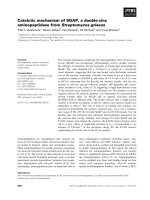
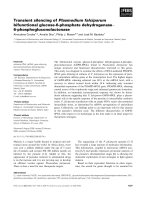
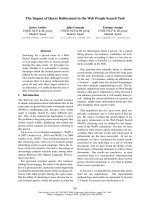
![Tài liệu Báo cáo khoa học: Specific targeting of a DNA-alkylating reagent to mitochondria Synthesis and characterization of [4-((11aS)-7-methoxy-1,2,3,11a-tetrahydro-5H-pyrrolo[2,1-c][1,4]benzodiazepin-5-on-8-oxy)butyl]-triphenylphosphonium iodide doc](https://media.store123doc.com/images/document/14/br/vp/medium_vpv1392870032.jpg)

